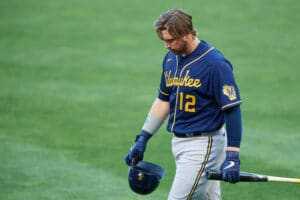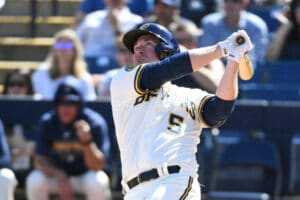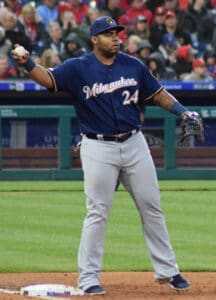The last decade of Brewers baseball has been as good as any in franchise history. By making the playoffs four times since 2010, Milwaukee ended up with more playoff appearances in the last ten years than they had in their first forty-one years combined. They made two trips to the NLCS and played a Game 7 with a spot in the World Series on the line. They produced two MVPs, replacing one star with another by trading for Christian Yelich as the mileage on Ryan Braun’s body started to catch up with him. The Brewers even developed a great young manager in Craig Counsell to help continue this era of prosperity into the future. Barring an actual World Series title, it would have been hard to write a better script for the Crew back at the beginning of 2010.
Of course, that doesn’t mean that everything has gone to plan, and one clear problem has existed within the organization: lacking consistency at first base.
No Heir to Prince’s Throne
Since Prince Fielder left in free agency after the loss in the 2010-2011 NLCS, Milwaukee has played eleven players at least forty games (or roughly one-quarter of a full season) at first base. Both Justin Smoak and Jedd Gyorko played 30 games in well under half of a full season last year, so I’ll add them to the list too. That’s a nine-year period with thirteen different players manning a single position for more than a quarter season each.
While some of those first basemen were just flat-out bad in Milwaukee, the primary issue has been consistency–only three of the thirteen played with the Brewers for more than one season. One was Jonathan Lucroy, whose primary position was catcher. The other two were Eric Thames and Jesus Aguilar, who operated a platoon at first from 2017-2019 while both went through various hot and cold streaks. At times, both looked like the long awaited permanent solution, but those times never lasted. The same could be said of anyone who has followed in Fielder’s steps.
Issues at First Stand Out
Before I go any deeper into the numbers of Milwaukee’s various first basemen, I should back up my point on the position’s inconsistencies with a look at how they compare across the field. If you look at the player movement at other positions, the lack of consistency at first becomes clear. I’ll put last year’s additions in parentheses to take out any potential chaos added by the shortened season:
- 1B: 11 players with 40 or more games since 2011 (+2 in 2020)
- C: 6 (+2)
- 2B: 9 (+0)
- SS: 10 (+2)
- 3B: 8 (+1)
- RF: 9 (+1)
- CF: 7 (+2)
- LF: 7 (+0)
No other position has seen as much turnover, and very few come all that close. For the Brewers, first base has been last in player longevity. Why has this been the case? The simple answer is that everyone has either been too old or not good enough to earn any sort of long-term commitment, never mind a central role like the one enjoyed by Fielder. Let’s run through the recent history:
Prince Fielder (2011)

Games: 159
Fielder was the standard throughout his six seasons in Milwaukee, and his final season was as good as any. He played all 162 games, hit 38 home runs, produced a .299 batting average, and walked 107 times. His .415 on-base percentage and 36 doubles were both high marks for his Brewers career, and Prince also drove in 120 runs. For some context on just how good those numbers were, let’s look at how they stacked up against the rest of the league:
| Stat | Fielder 2011 | League Rank (Among 1B) |
| HR | 38 | 5th (2nd) |
| BA | .299 | 27th (6th) |
| OBP | .415 | 4th (3rd) |
| Slugging % | .566 | 5th (2nd) |
| OPS | .981 | 5th (2nd) |
| RBI | 120 | 2nd (1st) |
| Walks | 107 | 4th (3rd) |
| 2B | 36 | T-22nd (5th) |
| Games Played | 162 | Solo 1st (1st) |
| WAR | 4.6 | 46th (5th) |
| Offensive WAR | 5.5 | 12th (4th) |
Prince Fielder was elite, and the Brewers have yet to find someone who can fill the big footsteps he left behind.
Corey Hart (2012)

Games: 103
Corey Hart is a Brewers legend. He was quite good at first after moving in from the outfield too. His 30 homers put him in the top 25 league-wide and, coincidentally, tied him with Fielder’s 2012 production in Detroit. His 35 doubles put him in the top 35 (and two ahead of Fielder). He hit for a .270 batting average that was well above the league average (.253). His .507 slugging percentage was also very good. To top it all off, Hart played almost every day with 149 games in 2012 (46 of those came in his old right field spot).
The problem was not the quality of his play but rather the length of his time at first base. Hart left Milwaukee after his lone season at first and retired two years later after playing just 103 games with the Mariners and Pirates. By the time Fielder left, Hart was only able to provide a single bridge year.
Travis Ishikawa (2012)

Games: 43
Ishikawa manned first base for the majority of games where Hart rested or played out in right. He was no star, but he did what he needed to do as a backup who only got more than one at-bat in 49 total games. The clear positives were the decent .257 average and the 30 RBIs in only 174 plate appearances. Ishikawa also hit a good amount of doubles (12) given his role, but he struggled to put the ball over the fence with only 4 home runs. To put it simply, Ishikawa was relatively successful at being a limited back-up. Credit to him for that, but he clearly wasn’t the long-term answer at first either.
Yuniesky Betancourt (2013)

Games: 68
The Yuniesky Betancourt era may never be forgotten, but most of it took place on the left side of the infield. Betancourt only played shortstop in his first year with the Brewers, and he returned one year later to split time between first and third. The 2013 numbers are far from impressive with an ugly .212 batting average, a poor .240 on-base percentage, and a 61 OPS+ that ranked 14th out of the seventeen Brewers that made at least 100 plate appearances. (OPS+ is essentially ballpark-adjusted OPS, which is slugging + OBP in its simplest form.) Betancourt finished the season, his last in the big leagues, with -2.3 WAR. Not great.
Juan Francisco (2013)

Games: 67
I remember absolutely nothing about Juan Francisco, but it appears that he was the primary first baseman for the Brewers after being acquired for a minor leaguer (Thomas Keeling) a few days into June. He was released after the season, which should tell you all you need to know about his time with Milwaukee. Francisco hit for a .221 average and struck out more than all but 30 players across Major League Baseball despite finishing 214th in plate appearances. He did provide some power with 13 homers and 32 RBIs in only 270 trips to the batter’s box, but that simply wasn’t enough reason to keep him around. Francisco only played more one season after his release.
Jonathan Lucroy (2013-2016)

Games: 46
Lucroy was a great Brewer, especially in 2014, but the vast majority of his time was spent behind the plate rather than at first. There’s not much point in going through his numbers because he was never anything more than an occasional fill-in at first. Lucroy wasn’t the long-term replacement for Fielder, and he was never meant to be.
Mark Reynolds (2014)

Games: 90
Reynolds had a very respectable thirteen year career that wrapped up in 2019. Unfortunately, his one year with the Brewers was far from his best. Reynolds hit for a .196 average in Milwaukee, and he couldn’t even get his on-base percentage above .300. His .394 slugging percentage was the second worst of his career, and his 9 doubles were easily a career low point if you adjust for differences in plate appearances. He hit 22 homers but didn’t break 50 in either RBIs or runs despite playing in about eight of every ten games. Reynolds played about 70% of those games at first, and the vast majority of the rest came at third. This was a one-year experiment, and it didn’t work out.
Lyle Overbay (2014)

Games: 83
Overbay returned to Milwaukee for his age-37 season, and it ended up being his last. He platooned with Reynolds, and the second time was not the charm after a successful two year run with the Brewers in 2004 and 2005. Overbay did draw a decent amount of walks (36 in under 300 plate appearances), but that was about it. He hit for a .233 average, only drove the ball out of the park 4 times, and was largely unspectacular. The expectations weren’t all that high given his age, but Overbay certainly didn’t produce one last run of great form before he retired.
Adam Lind (2015)

Games: 138
Lind, in 2015, was the first part of a two year run where the Brewers at least had a clear number one at first base, and he played pretty well. He hit for a .277 average, drove in 87 runs, and walked 66 times. Lind finished the year with 20 homers and 32 doubles. He easily had more hits (139) than strikeouts (100), and he produced 3.6 WAR, the second-best mark of his career. It was a good year of baseball.
The only issue for Lind’s long-term prospects was his age (31), and the Brewers flipped him to Seattle after the season in a trade that netted Freddy Peralta. That has obviously paid off since, and though Lind had two relatively decent seasons after leaving Milwaukee, he never got all that close to his 2015 play again. Like Corey Hart before him, he provided one good year at first before moving on. The search for a long-term solution was destined to continue.
Chris Carter (2016)

Games: 155
Carter followed Lind in playing dependable, every day baseball at first. His 41 homers led the NL, and he drove in 94 runs. Of course, he also led the NL in strikeouts with an ungodly 206. That put his batting average way down at .222, though his 76 walks helped make things a little prettier. There was good and there was bad with Carter, and his overall impact ended up somewhere in between. He was certainly no Prince Fielder, but it’s hard to complain about the year he gave the Brewers.
And it was just a year, as Carter moved on to the Yankees on a pretty cheap deal. Milwaukee obviously decided that the home runs weren’t worth the strikeouts, which was a defensible decision given the relatively high home run rate players tend to enjoy at Miller Park. Forty-one homers are great, but they become a little less important in a homer-heavy ballpark. Carter, like others before him, was not the same after leaving. He hit just 8 home runs and played only 62 games with New York, and he hasn’t played since.
Jesus Aguilar (2017-2019)
Games: 269
Aguilar had one heck of a 2018, and it earned him an All-Star nod. He hit 35 home runs, drove in 108 runs, and scored 80 times. His .274 batting average was good, and he was second on the team to only Christian Yelich in OPS+ (135). The whole season wasn’t perfect, especially at times in the second half, and Aguilar finished with more than 130 strikeouts. It was still a very good year overall. Unfortunately, that was his only great year in a Brewers uniform. His 2017 was pretty good but rather limited in volume. He only went to the plate 311 times, and that hurt his overall numbers–40 runs, 52 RBIs, 15 doubles, 16 homers. Aguilar hit for a .265 average that season.
Then there was 2019, his worst season in Milwaukee. Aguilar hit .225 and only managed 8 homers and 34 RBIs in 262 plate appearances, and his early struggles led to the mid-season trade that sent him to Tampa for reliever Jake Faria. It was a success story to get just the one All-Star season from Aguilar after he played 35 total games in three seasons with Cleveland before the Brewers picked him up, but this success story had a sad ending.
Eric Thames (2017-2019)

Games: 242
Like Aguilar, Thames had his highs and his lows with the Brewers. He was probably a slight positive overall. The batting average was never great, topping out at .247 in both 2017 and 2019. That meant a lot of strikeouts, but Thames was also able to walk enough to keep his on-base percentage above .300 all three years and above .340 twice. He hit for power too, totaling 96 home runs (one in every 13.4 plate appearances) and topping 20 doubles and 60 RBIs in both 2017 and 2019. That all led to good OPS numbers in all three years. With the league average typically somewhere between .720 and .760, Thames went over .800 twice and finished with a .783 OPS in 2018.
The overall numbers don’t tell the full story of his occasional ups-and-downs, but it’s fair to say that Thames largely had a positive impact. For the first time in years, Thames (and Aguilar) gave the Brewers a consistent presence at first base across multiple seasons. They weren’t consistent All-Stars, but they were a clear step forward. And then both were gone.
Justin Smoak (2020)

Games: 31
Smoak was a “hope-this-works” kind of signing, and it didn’t work. He didn’t return to the form that produced an outlier All-Star season in 2017, and he didn’t even make it past the first week of September before he was released. Smoak hit for a terrible .186 average, almost doubled his hits (21) with his strikeouts (40), smacked just one homer for every 25.2 plate appearances, and finished his time with the Brewers with -0.5 WAR produced, tied for his lowest ever output. The Smoak experiment was a very clear failure, as many expected (to some degree) from the start.
Jedd Gyorko (2020)

Games: 30
Gyorko was one of the better surprises of 2020 for the Brewers. Splitting time between first and third, he did a decent job. He hit for .248 (which was quite good considering how the rest of the team hit), produced an OPS of .838, and hit 9 homers in 135 plate appearances. With that said, his play was likely considered to be better than it actually was just because of how poorly the team as a whole played offensively. The version of Gyorko that showed up late shouldn’t be one of your leading offensive options, and yet he was as close to the top as anyone by the end of the season. But, there’s no question that he stepped in and filled a role that was open after Smoak’s failures. He did his job, and he did it well.
Is Daniel Vogelbach the next man up?

The next Prince Fielder isn’t going to be in Milwaukee by this spring, so what can the Brewers do to get the most out of the first base position this season? Neither Gyorko or Smoak is on the current roster, which leaves Daniel Vogelbach as the man in line for the job. While Vogelbach was a great story last year when he came in at the end of the season and hit for a .328 average with a .987 OPS, I would be shocked if we end up relying this much on a guy who only had 61 plate appearances with the team. Vogelbach did show signs of being a power threat when he hit 30 home runs and drove in 76 runs the year before last with Seattle, but he’s shown no signs in the past of an ability to replicate last year’s batting average.
Potential Platoon Options
That means that signing someone else would likely be the smart move to at least provide Craig Counsell with two options at first throughout the season. As Thames and Aguilar have shown in recent years, a platoon between two guys with high ceilings and consistency issues can end up working out pretty well.
There are three names on the market that currently stand out: Thames, Gyorko, and Travis Shaw. While guys like Asdrubal Cabrera and Danny Santana might potentially represent upgrades, there’s no one out there that’s a clear, can’t-miss candidate to chase after. Why not take a chance on the guys that have had some success with you in the past? Chemistry has been a key part of the recent winning culture in Milwaukee, and it’s the best thing to lean on when the available free agents are relatively equal by talent. I would be happy to see a familiar face returning to American Family Field, better known as Miller Park, this spring.
Follow For More!
Looking for more great content on the Milwaukee Brewers? Follow me on Twitter at @MikeRegan09 and follow us at @WiscoHeroics1! To read more of our articles and keep up to date on the latest on all things Wisconsin sports, click here.






